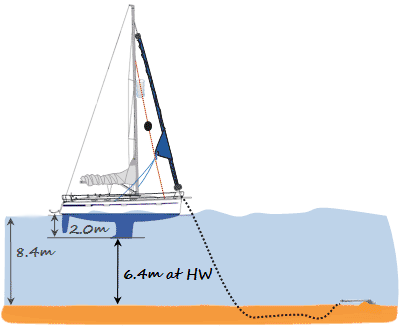Insight into finding the height of tide for various times of the day.
These graphical curves allow us to fine the height of tide at a particular time, or alternatively, what time will a specific height of tide occur.
In this example
a vessel with a draught 1.2m has arrived at an anchorage at 1030 Daylight Savings Time (DST).
The skipper is
looking to have at least 1m of water under the keel at the next LW.
In this example, we have obtained the following tidal information from the tide tables:
For this example we can say there is a fall of tide of 2.7m between 1030 DST and the
next low water.
2.7m fall + 1.2m draught + 1m clearance = 4.9m depth required to anchor in.
This animation is best viewed on a computer or tablet, or rotate your phone to landscape for the best representation.
Copyright Navathome.com
This is a tidal curve which is used to find the height of tide for various times between HW and LW.
To use it, we need to go to the tide tables and obtain the time of HW adding an hour for DST if it is summer tIme.
Enter the time of HW in the HW box at the bottom of the graph.
In this example the time and height of HW and the height of LW has already been obtained from the tide table and is given as HW 1230 4.2m, LW 0.4m.
The range = HW - LW = 3.8m.
From the small box to the right of the curve we can see that this is a spring range.
The HW box has been filled in with the HW time of 1230 DST The next step is to fill in the - 1 hour to - 5 hour boxes.
The - 1 hour box should be filled in with 1130, the - 2 hour box with 1030 and so on.
To finish setting up the graph the tidal height line needs to be added.
Example. A skipper prepares to anchor a vessel at 1030 which is 2 hrs before HW and wishes to make sure the yacht doesn't ground. The formula is draught + required clearance (say 1m), + the amount the tide will fall.
Draught + clearance + fall of tide = minimum depth to anchor in.
Plot a line up to the spring (red line) curve from the 1030 mark on the time boxes.
The next low water will be around 1830 DST 0.4m
Note that the small divisions between the hours are in 10 minute segments.
From the point where the 1030 line touches the spring line of the tidal curve, take a second line accross to the HW/LW line. Then a third line from the HW/LH line up to the HW scale.
The height of tide at 1030 will be 3.1m.
0.4m
4.2m
The next step, The high water + 1 to HW + 5 hour boxes should be filled in by increasing each box by one hour from the HW box to the HW + 5 box.
The next step is to mark off the HW height of 4.2m on the top scale of the graph and the LW height of 0.4m on the bottom scale.
1730
1330
1230
1130
0930
0830
0730
1030
1430
1530
1630
3.1m
The skipper wishing to anchor at 1030 DST now knows that the height of tide at 1030 DST will be 3.1m and the next LW will be 0.4m which is where the tide will fall to at around 1830 DST.
3.1m - 0.4m = 2.7m fall of tide. The water level will be 2.7m less at the next LW. If the draught of the vessel is 1.2m and the skipper requires clearance of 1.0m then the minimum depth to anchor in at 1030 DST would be 2.7m fall of tide + 1.2m draught + 1m clearance = 4.9m.
The skipper can use the information obtained from the tidal curve to work out how much anchor chain to lay out at 1030.
The height of tide was calculated to be 3.1m at 1030 DST The tide will rise by 1.1m to 4.2 at HW.
The depth to anchor in at 1030 was calculated as 4.9m. Therefore 4.9m + 1.1m rise of tide to HW = 6.0m max depth at HW. 6m x 4 = 24m of chain should be used.
The tidal curve can be used to find how much the tide will fall between the time we arrive and low water.
Looking at the tidal curve:
The bottom of the actual curve represents low water and the top represents high water.
The curved line represents the rate the tide rises or falls.
The solid line on the curve is for spring tides and the dashed line is for neap tides.
Always check this information which is usually given in a small box at the side of the tidal curve on the chart you are using. On some charts it could be dashed for neaps and solid for springs.
(The box at the top right of the graph showing the mean tidal ranges can be used to check this).
The yacht opposite is anchored in 8.4m of water.
It has a draught of 2.0m.
Therefore, it has 6.4m of water under the keel.
If the tide is going to fall by 5.4m to the next low water, the
clearance will be 6.4 - 5.4 =1.0m under the keel at LW.

Initial depth at time of anchoring (8.4m) - fall of tide (5.4m) =
Low water depth (3.0m)
Low water depth (3.0m) - draught (2.0m) = clearance (1m)
